New Mexico Legislators Introduce Bill to Outlaw Trapping on Public Lands - National Humane Education Society

Paws Up! To the New Mexico Senate for advancing a bill that would protect people and animals from dangerous and inhumane traps on public land.
February 5, 2021
Two years ago, a blue heeler named Roxy got caught in a trap near a lake in New Mexico, and she was strangled to death. Since then, legislators and animal rights groups in New Mexico have been advocating for the banning of traps, wildlife poisons, and snares on public land.

Senate Bill 32, or Roxy’s Law, would prohibit the use of these cruel trapping methods on public lands in New Mexico in order to prevent tragedies like Roxy’s death from happening again. Those who violate the law would be given misdemeanor penalties.
Opponents of the law argue that the traps serve to protect livestock that graze on public lands from potential predators.
Animals who are caught in traps and snares often endure long, agonizing deaths caused by starvation, thirst, and exposure because hunters who set the traps may wait several hours or days before checking them. Many times these animals were not even the animal the hunter was targeting, and are often someone’s dogs who are exploring the area off-leash.
Why is trapping inhumane? Here is how the most used types of traps work:

- A steel-jaw leghold trap operates just as the name implies. This trap is designed to snap closed on an animal’s leg—or any part of the animal it happens to close on—holding the animal there until the trapper arrives. These traps rip flesh, sever tendons, and break bones.
- The Conibear® trap is similar in design to the steel-jaw leghold trap in that it is designed to snap shut when the trigger is activated. The major difference between these two traps is that the Conibear® is a larger, full body trap designed to snap shut at the base of the captured animal’s spinal chord, instantly killing the animal. However, it is rare that an animal happens to trigger one of these traps in the absolute perfect position. Therefore, it is rare that an animal trapped in a Conibear® is killed instantly.
- A snare trap is merely a coil of wire fashioned into a noose at one end, with an anchor at the other end. Snares can catch animals by the neck, midsection, or a limb. As the animal tries to become free from the trap, the wire grows tighter around the animal’s body.
Take Action
The New Mexico Senate Conservation Committee has endorsed Roxy’s Law and will be voted on by the full Senate next.
New Mexico residents, please contact your state senators and tell them to vote in favor of Roxy’s Law!









I would hope that Roxy’s Law becomes the law of the country as too many animals are being killed by these barbaric traps. I’m in favor of Roxy’s Law 100%!
These traps are cruel and inhumane. No animal should be subjected to such treatment. Could you imagine a child getting caught in one of these? Please vote against them.
The trapping must be stopped!
No traps. We are cruel enough.